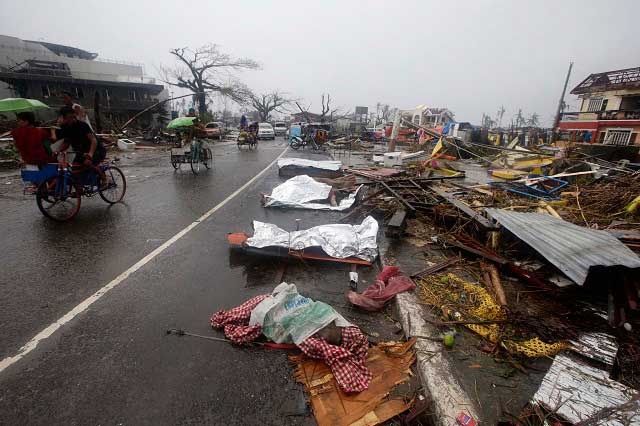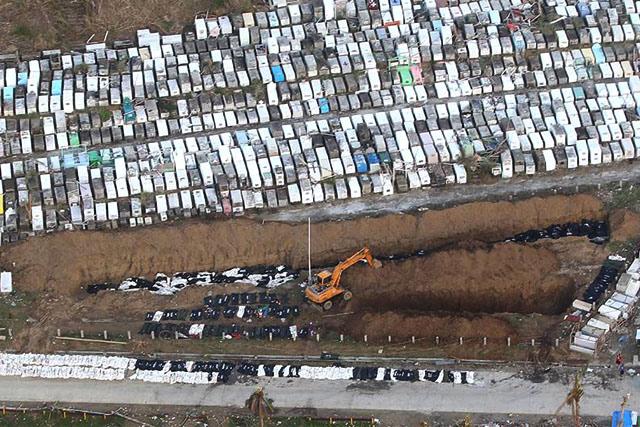
In the aftermath of Typhoon Yolanda (international codename Haiyan), the streets of badly battered areas were filled not only with fallen trees and collapsed houses and buildings, but also with bodies of the cyclone's casualties.
Presidential spokesperson Edwin Lacierda on Monday, November 11, said both the Department of Public Works and Highways and the engineering brigade of the military were already instructed to start clearing operations.
But there is an urgency to collect and bury corpses lying around for 4 days now since Friday – and this is not because they pose a risk of communicable disease, the World Health Organization (WHO) clarified.
In its technical note “Disposal of dead bodies in emergency conditions,” WHO said disposing dead bodies during disasters like Super Typhoon Yolanda is important mainly because of the pyschological trauma the bodies may cause to those “witnessing death on a large scale.”
But ample time must be given to identify the bodies.
Two different viewing spaces
The international organization said separate viewing locations should be provided during emergencies: one for viewing a body for identification, and another for viewing a body for grieving purposes.
In Tacloban City, where the Philippine Red Cross estimated at least 1,200 to be dead, WHO standards require an area of over 2,000 square meters if it is to be used to display bodies for identification.
Identification of dead bodies is a lengthy and challenging process, especially when they do not carry any personal information, and relatives have to scour numerous bodies to find their loved ones.
“Once identified, a death certificate should be issued, an official record of death prepared, and the body tagged,” WHO added.
Burial and cremation
WHO discouraged burial in common graves and mass cremation, and preferred burial over cremation. The following conditions must be met in identifying a graveyard location:
- should be agreed with the community
- ground conditions must be given attention
- at least a 50-m proximity to groundwater drinking sources
- at least a 500-m proximity to the nearest habitat
- an area of at least 1,500 square meters per 10,000 population
- burial depth of at least 1.5 m above groundwater table, with at least a 1-m soil covering
- Individual graves are preferred, and in the absence of coffins, bodies must be covered by a plastic sheeting to separate it from the soil.
If the community prefers cremation, WHO said a site for this should be located at least 500 meters downwind of dwellings.
Mortuary sites
But if burial and cremation is likely to be delayed, a temporary mortuary site may be put up. WHO recommended a field morgue capacity of 10 bodies per 10,000 population. If possible, bodies should be stored at 4ºC.
Equipment for mortuary services in major disasters include:
- stainless steel postmortem tables or heavy duty trestle tables covered with plastic sheeting
- wheeled trolleys for transporting bodies within the mortuary
- tarpaulin or plastic sheeting for the floor, if it is not made of concrete
- heavy-duty black plastic sheeting for temporary screens
- refuse bins and bags
- cleaning materials – mops, buckets, cloths, soap, towels
- disinfectant and deodorizer
- protective clothing and heavy-duty rubber gloves
- translucent plastic body bags 0.1 mm thick and labels (if epidemic circumstances)
- wall charts to record progress or large poster boards if there are no walls
- But at a minimum, the following must be provided in a mortuary site: stretchers, leather gloves, rubber gloves, overalls, boots, caps, soap, disinfectants and cotton cloth. Appropriate cleansing of the site must be done when closing it down.
The Department of Health (DOH) said refrigerated vans or dry ice – and not lime, muriatic acid, or potassium alum (tawas) – should be used to avoid the rapid decay of dead bodies.
Epidemics
In case of a medical epidemic, handling of bodies must be left to experts. Burial or cremation must be done immediately after death, but the size of the gathering in the funeral must be limited to avoid spreading the epidemic.
WHO also provided quick guidelines on how to prevent the spread of an epidemic after being in contact with corpses. To prevent a cholera epidemic, careful washing with soap and water is required once exposed to cholera vibrios present in dead bodies.
Ebola, which easily spreads through bodily secretions like blood and saliva, can also be killed by careful washing, according to WHO.
But DOH noted that infectious microorganisms present in dead bodies is not viable after 48 hours.
Handling of corpses is also crucial. Protective clothing should be worn to avoid fleas and lice that could spread these diseases. WHO also said bodies must be stored in body bags before burial or cremation
Wednesday 20 November 2013
http://www.rappler.com/move-ph/issues/disasters/typhoon-yolanda/43453-who-handling-corpses-disasters




